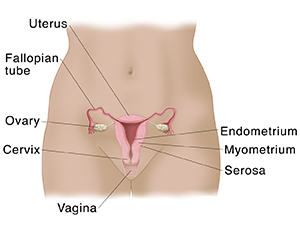Uterine Sarcoma: Introduction
What is cancer?
Cancer starts when cells in the body change (mutate) and grow out of control. To help you understand what happens when you have cancer, let’s look at how your body works normally.
Your body is made up of tiny building blocks called cells. Normal cells grow when your body needs them, and die when they're damaged or your body no longer needs them.
Cancer is made up of abnormal cells that grow even though your body doesn’t need them. In most cancers, the abnormal cells grow to form a lump or mass called a tumor. If cancer cells are in the body long enough, they can grow into (invade) nearby areas. They can also spread to other parts of the body (metastasize).
What is uterine sarcoma?
Uterine sarcoma is a rare cancer that starts in the thick muscular wall and supporting tissues of the uterus. The muscular wall is called the myometrium. Most uterine cancers are not uterine sarcoma, they're endometrial carcinomas. These cancers start in the inner lining of the uterus.
Understanding the uterus
The uterus is an organ that’s part of the female reproductive system. You may know it as the womb. It's where a baby grows during pregnancy.
The uterus is usually pear-shaped and about the size of a fist. It's in the lower belly (pelvic area), between the bladder and the rectum. The uterus is connected to the fallopian tubes. These tubes carry eggs from the ovaries into the uterus. The small opening that connects the uterus to the vagina is the cervix.
The uterus is made up of three layers:
-
Endometrium. This is the innermost lining. (It's where endometrial cancer starts. This is the much more common kind of uterine cancer.)
-
Myometrium. This is the middle layer of thick muscle.
-
Serosa. This is the smooth outer layer that coats the uterus.
During labor, the myometrium muscle helps push the baby out through the cervix. The smooth serosa makes it easy for the uterus to slide and move in the pelvis as needed.

How uterine sarcoma spreads
If uterine sarcoma spreads, it tends to first go to places near the uterus. It can spread to the cervix, vagina, ovaries, fallopian tubes, and lymph nodes. In later stages, as it grows, it can spread to the bladder, bowel, lungs, liver, or bone.
Cancer that spreads to other parts of the body is called metastatic cancer. The process of spreading is called metastasis. Metastasis is a complex process. The cancer cells of the tumor in the uterus grow into other tissues, blood vessels, and the lymph system. The cells then travel through the bloodstream or the lymph system to reach other parts of the body, where they can grow into new tumors.
The tumors in these new areas are still uterine sarcomas. So, when this cancer spreads to the lungs, for instance, the cells in the lung tumor are uterine sarcoma cells, not lung cancer cells. And the disease is called metastatic uterine sarcoma, not lung cancer.
Talk with your healthcare provider
If you have questions about uterine sarcoma, talk with your healthcare provider. Your healthcare provider can help you understand more about this cancer.